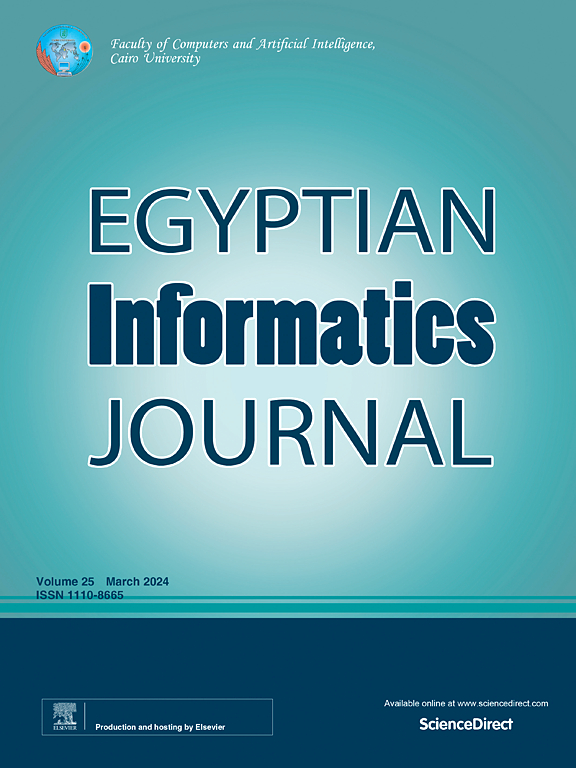Advanced skin lesion segmentation and classification using adaptive contextual GLCM and deep learning hybrid models
IF 4.3
3区 计算机科学
Q1 COMPUTER SCIENCE, ARTIFICIAL INTELLIGENCE
引用次数: 0
Abstract
One of the most common and dangerous types of cancer, skin cancer, especially melanoma, is distinguished by its quick spread and high death rate if left untreated. It is impossible to overestimate the significance of early detection and precise diagnosis as they are essential for successful treatment and greatly raise patient survival rates. To improve skin lesion segmentation and classification, this work presents a state-of-the-art image analysis technique that uses hybrid deep learning models in conjunction with the Adaptive Contextual Gray Level Co-occurrence Matrix (GLCM). DeepLabV3 + is used to segment the skin lesion from pre-processed input images with high accuracy. A Long Short-Term Memory (LSTM) network trained on characteristics collected by the Adaptive Contextual GLCM is included to further evaluate the segmented images. Because of this special combination, the model can accurately capture contextual information and tiny texture differences, both of which are essential for differentiating between benign and malignant skin lesions. Our suggested approach performs very well in tasks involving both segmentation and classification. In particular, it attains a remarkable 98.34 % accuracy, 99.13 % specificity, 97.25 % sensitivity, 97.15 % Dice coefficient, and 98.6 % F1 score. These findings demonstrate the method’s stability and dependability, which makes it a potentially useful instrument for raising the detection accuracy of skin cancer. This approach has the potential to transform early detection procedures by providing improved diagnostic accuracy and resilience, eventually contributing to better patient outcomes and more effective management of skin cancer cases.
使用自适应上下文GLCM和深度学习混合模型的高级皮肤病变分割和分类
皮肤癌,尤其是黑色素瘤,是最常见和最危险的癌症之一,其特点是扩散迅速,如果不及时治疗,死亡率很高。早期发现和准确诊断的重要性再怎么高估都不为过,因为它们对于成功治疗和大大提高患者存活率至关重要。为了改善皮肤损伤的分割和分类,这项工作提出了一种最先进的图像分析技术,该技术使用混合深度学习模型与自适应上下文灰度共生矩阵(GLCM)相结合。DeepLabV3 +用于从预处理的输入图像中高精度地分割皮肤病变。利用自适应上下文GLCM收集的特征训练长短期记忆(LSTM)网络,进一步对分割后的图像进行评价。由于这种特殊的组合,该模型可以准确地捕获上下文信息和微小的纹理差异,这两者对于区分良性和恶性皮肤病变都是必不可少的。我们建议的方法在涉及分割和分类的任务中表现非常好。准确率为98.34%,特异性为99.13%,敏感性为97.25%,Dice系数为97.15%,F1评分为98.6%。这些发现证明了该方法的稳定性和可靠性,这使其成为提高皮肤癌检测准确性的潜在有用工具。这种方法有可能通过提高诊断准确性和恢复力来改变早期检测程序,最终有助于改善患者预后和更有效地管理皮肤癌病例。
本文章由计算机程序翻译,如有差异,请以英文原文为准。
求助全文
约1分钟内获得全文
求助全文
来源期刊

Egyptian Informatics Journal
Decision Sciences-Management Science and Operations Research
CiteScore
11.10
自引率
1.90%
发文量
59
审稿时长
110 days
期刊介绍:
The Egyptian Informatics Journal is published by the Faculty of Computers and Artificial Intelligence, Cairo University. This Journal provides a forum for the state-of-the-art research and development in the fields of computing, including computer sciences, information technologies, information systems, operations research and decision support. Innovative and not-previously-published work in subjects covered by the Journal is encouraged to be submitted, whether from academic, research or commercial sources.
 求助内容:
求助内容: 应助结果提醒方式:
应助结果提醒方式:


